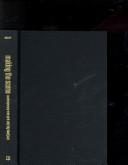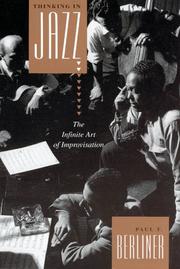| Listing 1 - 3 of 3 |
Sort by
|
Book
ISBN: 128207007X 9786612070075 0226534790 Year: 1996 Publisher: Chicago : University of Chicago Press,
Abstract | Keywords | Export | Availability | Bookmark
 Loading...
Loading...Choose an application
- Reference Manager
- EndNote
- RefWorks (Direct export to RefWorks)
This fresh look at the neglected rhythm section in jazz ensembles shows that the improvisational interplay among drums, bass, and piano is just as innovative, complex, and spontaneous as the solo. Ingrid Monson juxtaposes musicians' talk and musical examples to ask how musicians go about "saying something" through music in a way that articulates identity, politics, and race. Through interviews with Jaki Byard, Richard Davis, Sir Roland Hanna, Billy Higgins, Cecil McBee, and others, she develops a perspective on jazz improvisation that has "interactiveness" at its core, in the creation of music through improvisational interaction, in the shaping of social communities and networks through music, and in the development of cultural meanings and ideologies that inform the interpretation of jazz in twentieth-century American cultural life. Replete with original musical transcriptions, this broad view of jazz improvisation and its emotional and cultural power will have a wide audience among jazz fans, ethnomusicologists, and anthropologists.
Jazz --- Improvisation (Music) --- Criticism and interpretation. --- ethnomusicology, musical techniques, jazz music, rhythm section, fresh look, ensembles, improvisational interplay, piano, drums, bass, innovative, complex, spontaneous, musicians talk, examples, saying something, race, politics, identity, cecil mcbee, billy higgins, sir roland hanna, richard davis, jaki byard, improvisation, interactiveness, tempo, timing, social communities, ideologies, 20th century, united states, african-american, musicology, anthropology, sociology, history.

ISBN: 1282358677 9786612358678 0520940164 9780520940161 9780520249530 0520249534 9780520249547 0520249542 9781282358676 661235867X Year: 2007 Publisher: Berkeley University of California Press
Abstract | Keywords | Export | Availability | Bookmark
 Loading...
Loading...Choose an application
- Reference Manager
- EndNote
- RefWorks (Direct export to RefWorks)
The received wisdom of popular jazz history is that the era of the big band was the 1930s and '40s, when swing was at its height. But as practicing jazz musicians know, even though big bands lost the spotlight once the bebop era began, they never really disappeared. Making the Scene challenges conventional jazz historiography by demonstrating the vital role of big bands in the ongoing development of jazz. Alex Stewart describes how jazz musicians have found big bands valuable. He explores the rich "rehearsal band" scene in New York and the rise of repertory orchestras. Making the Scene combines historical research, ethnography, and participant observation with musical analysis, ethnic studies, and gender theory, dismantling stereotypical views of the big band.
Big bands --- Big band music --- History and criticism. --- 20th century american culture. --- 20th century american music. --- american jazz. --- american music. --- bandleaders. --- big band. --- big bands. --- career. --- era of big bands. --- ethnic studies. --- ethnography. --- gender studies. --- jazz historiography. --- jazz music. --- jazz. --- musical analysis. --- musical ensemble. --- musicians. --- new york city. --- participant observation. --- performing arts. --- popular jazz history. --- rehearsal band. --- rhythm section. --- saxophones. --- sections of instruments. --- swing music. --- theatre. --- trombones. --- trumpets. --- written arrangements. --- written compositions.

ISBN: 0226043800 1282538705 9786612538704 0226044521 Year: 1994 Publisher: Chicago : University of Chicago Press,
Abstract | Keywords | Export | Availability | Bookmark
 Loading...
Loading...Choose an application
- Reference Manager
- EndNote
- RefWorks (Direct export to RefWorks)
A landmark in jazz studies, Thinking in Jazz reveals as never before how musicians, both individually and collectively, learn to improvise. Chronicling leading musicians from their first encounters with jazz to the development of a unique improvisatory voice, Paul Berliner documents the lifetime of preparation that lies behind the skilled improviser's every idea. The product of more than fifteen years of immersion in the jazz world, Thinking in Jazz combines participant observation with detailed musicological analysis, the author's experience as a jazz trumpeter, interpretations of published material by scholars and performers, and, above all, original data from interviews with more than fifty professional musicians: bassists George Duvivier and Rufus Reid; drummers Max Roach, Ronald Shannon Jackson, and Akira Tana; guitarist Emily Remler; pianists Tommy Flanagan and Barry Harris; saxophonists Lou Donaldson, Lee Konitz, and James Moody; trombonist Curtis Fuller; trumpeters Doc Cheatham, Art Farmer, Wynton Marsalis, and Red Rodney; vocalists Carmen Lundy and Vea Williams; and others. Together, the interviews provide insight into the production of jazz by great artists like Betty Carter, Miles Davis, Dizzy Gillespie, Coleman Hawkins, and Charlie Parker. Thinking in Jazz overflows with musical examples from the 1920s to the present, including original transcriptions (keyed to commercial recordings) of collective improvisations by Miles Davis's and John Coltrane's groups. These transcriptions provide additional insight into the structure and creativity of jazz improvisation and represent a remarkable resource for jazz musicians as well as students and educators. Berliner explores the alternative ways-aural, visual, kinetic, verbal, emotional, theoretical, associative-in which these performers conceptualize their music and describes the delicate interplay of soloist and ensemble in collective improvisation. Berliner's skillful integration of data concerning musical development, the rigorous practice and thought artists devote to jazz outside of performance, and the complexities of composing in the moment leads to a new understanding of jazz improvisation as a language, an aesthetic, and a tradition. This unprecedented journey to the heart of the jazz tradition will fascinate and enlighten musicians, musicologists, and jazz fans alike.
Jazz --- Improvisation (Music) --- Jazz musicians --- jazz, improvisation, creativity, music, ethnomusicology, musicology, trumpet, miles davis, coltrane, performance, composition, bands, venues, rhythm section, rehearsal, precomposition, community, charlie parker, coleman hawkins, dizzy gillespie, betty carter, vea williams, carmen lundy, red rodney, wynton marsalis, art farmer, doc cheatham, curtis fuller, james moody, lee konitz, lou donaldson, barry harris, tommy flanagan, emily remler, akira tana, ronald shannon jackson, max roach, rufus reid, george duvivier, nonfiction, analysis. --- History and criticism.
| Listing 1 - 3 of 3 |
Sort by
|

 Search
Search Feedback
Feedback About UniCat
About UniCat  Help
Help News
News